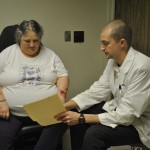
Hospital Engagement Networks are bringing together pharmacists, physicians, and nurses to improve patient outcomes in areas such as preventable infections, adverse drug events, and preventable readmissions.
A COLLABORATION BETWEEN ASHP and the American Hospital Association is yielding exciting opportunities for pharmacists to improve patient care across the country.
The two organizations are working together to increase pharmacist participation in Hospital Engagement Networks (HENs), part of the Centers for Medicare & Medicaid Services’ (CMS’s) Partnership for Patients program.
Approximately 3,700 hospitals participate in HENs, choosing among 10 areas in which to improve quality measures, including surgical site infections, adverse drug events, central line-associated bloodstream infections, venous thromboembolism, catheter-associated urinary tract infections, ventilator-associated pneumonia, and preventable readmissions.
The hospitals then share their successes with partnering organizations to help others replicate what they have achieved.
Pharmacists are a Natural Fit
Because so many of the primary goals for HENs involve medication therapy, pharmacists are in a perfect position to help as medication experts on the health care team. And when the American Hospital Association’s Health Research and Educational Trust (HRET) received a CMS grant to create a HEN, approaching ASHP seemed like a no-brainer.
The HRET HEN is focused on identifying solutions that are already reducing health care-acquired conditions and disseminating them to other hospitals and health care providers, according to David G. Schulke, HRET’s vice president of research programs in Washington, D.C.
“It was natural to reach out to ASHP because many readmissions are attributable to breakdowns in drug therapy, and pharmacists are well-trained and have tremendous knowledge in that area,” Schulke said. “I’ve worked with pharmacists and ASHP for many years, and HRET wanted to see if we could use that existing relationship to knit pharmacists into the HEN’s implementation teams.”
ASHP then turned to its strong network of state affiliates to reach members who might be interested in participating.
“Depending on what a state affiliate is focusing on, they may be able to recruit pharmacists to get involved,” said Beverly L. Black, MHSA, CAE, ASHP’s director of affiliate relations. She added that pharmacists attend workshops as presenters or participants, work within their health systems to design and implement quality improvement programs as part of the HEN, and forge strong partnerships among state health-system pharmacy groups and state hospital associations.
“These relationships are important because we are common stakeholders in ensuring that patients receive optimal therapy.”
Narrowing the Focus
Developing initiatives relevant to a hospital’s or health system’s needs, measuring outcomes, and sharing information with other providers in the network are major facets of the HRET HEN.
At Purdue University’s Center for Medication Safety Advancement in Indiana, pharmacists collaborated with the Indiana Hospital Association to create the Indiana Medication Safety Alliance. Last November, the Alliance hosted a conference about medication safety, ADEs and readmissions. Now the group has its own website, provides ongoing coaching, and hosts conference calls every other month or so.
The group initially focused on two measures, successful anticoagulation with warfarin and avoidance of hypoglycemia among insulin users, but has since whittled its efforts down to improving anticoagulation.
Narrowing the focus was essential because the HEN’s guidance offers so many possible areas for improvement, said John B. Hertig, Pharm.D., M.S., the Center’s associate director.
“The HRET HEN’s Encyclopedia of Measures contains more than 100 distinct measures. So, zeroing in on warfarin was a strategic decision because the HEN was looking at patient harm with regard to ADEs and the hospitals in Indiana were reporting [issues with anticoagulation] more than anything else,” Hertig said.
At the University of Arkansas for Medical Sciences in Little Rock, the focus is on reducing readmissions for heart failure patients.
“When Medicaid announced penalties for pneumonia, acute myocardial infarction, and heart failure, we decided to take a look at how that would affect us,” said Niki Carver, Pharm.D., assistant director of pharmacy.
“After working on medication reconciliation for years, I wondered if there was a way the pharmacy could be notified when heart failure patients were admitted so the pharmacy could obtain medication histories for those patients.”
Carver knew such an effort would have an impact on the pharmacy’s workload, so she created an elective rotation for fourth-year pharmacy students that tasks them with obtaining medication histories and assisting in quality improvement efforts. Thus far, reductions in monthly readmission rates for patients with congestive heart failure have ranged from 1.67 to 4.43 percent.

Above left, Leigh Efird, Pharm.D., BCPS, clinical pharmacy specialist, The Johns Hopkins Hospital, teaches a patient how to properly use an insulin pen.
Working Smarter, Not Harder
The Hospital Consumer Assessment of Healthcare Providers and Systems Survey (HCAHPS) served as a catalyst for involving pharmacists in the HRET HEN at The Johns Hopkins Hospital in Baltimore, where their goal is to improve HCAHPS scores for medication-related questions.
“When we partnered with the Maryland Hospital Association, they knew we were working on issues related to HCAHPS,” said Meghan Davlin Swarthout, Pharm.D., MBA, BCPS, division director, ambulatory and care transitions.
“We were able to take actionable steps toward our goals and share information with other hospitals about our successes.”
Swarthout said that the hospital has increased its “Always” HCAHPS score from the 48th percentile in the second quarter of FY2013 to the 84th percentile in the fourth quarter for the survey question, “When I left the hospital, I clearly understood the purpose for taking each of my medications.”
Swarthout also stressed the value of sharing information within the network. “Sometimes the goals for quality and safety can be overwhelming. HENs bring in the expertise of your peers, and they can help you target your biggest problems,” she said.
Carver noted that HENs eliminate redundancy. “You hear what other hospitals have done, take what you need for your institution, make changes that fit your setting and implement them, instead of starting something from scratch.”
Pharmacist involvement in the HRET HEN is still fairly sporadic. For example, in a statewide workshop of roughly 250 attendees that Swarthout attended, only about 10 participants were pharmacists. Yet despite the relatively small number of pharmacists there, they made an impact: Once the other participants heard what the pharmacists had to say about safe medication use, many indicated they would promote better use of pharmacists’ skill within their own institutions.
ASHP is hopeful that by encouraging affiliate members to participate in the state-level HENS, other health systems will likewise more fully understand the valuable role that pharmacists play in ensuring patient safety and optimal health outcomes.
“We believe that if more pharmacists knew the benefits of participating in the HENs network, they would be more interested in participating,” Swarthout said. “We all have days when it feels like we’re not making any improvements, and that can be discouraging. But when you hear other people in the HEN talk about the same things, you realize you are not alone. You come away with ideas and external motivation.”
Showcasing Pharmacists’ Skills
HENs are also an excellent way to advance the profession, according to Hertig.
“It’s an opportunity for pharmacists to showcase their skills and abilities as members of interdisciplinary teams,” he said. “But it’s also in line with ASHP’s Pharmacy Practice Model Initiative in that it helps pharmacists work at the top of their licenses. What better avenue to show the impact we can have than a federal program where we work with nurses, physicians, and other professionals?”
Shekhar Mehta, Pharm.D., M.S., ASHP’s director of clinical guidelines and quality improvement, agreed.
“ASHP is primarily concerned with patient care, medication-use safety, and ensuring that pharmacists are part of a collaborative care team. So, this initiative supports all those goals,” he said.
“Pharmacists are also the most knowledgeable members of the team when it comes to medication use, and that’s a big issue in health care reform in improving the quality of care and lowering readmissions.”
Ultimately, patients are the ones who benefit most, said Carver.
“Skeptics will say that it’s more work for pharmacists, and it is. But if you’re in hospital pharmacy, you’re in it to improve patient care. And the outcomes you will see with this program are astounding.”
—Terri D’Arrigo
Editor’s Note: Interested in getting involved with an HRET HEN program? Send an email to [email protected], and we’ll put you in touch with the right resources within your state.











 If you want to contribute tutorials, news or other stuff please contact us. We pay 150 for each approved article.
If you want to contribute tutorials, news or other stuff please contact us. We pay 150 for each approved article. Consectetur adipisicing elit. Sed do eiusmod tempor incididunt ut labore.
Consectetur adipisicing elit. Sed do eiusmod tempor incididunt ut labore. This site uses valid HTML and CSS. All content Copyright © 2010 Newscast, Inc
This site uses valid HTML and CSS. All content Copyright © 2010 Newscast, Inc If you like what we do, please don't hestitate and subscribe to our
If you like what we do, please don't hestitate and subscribe to our